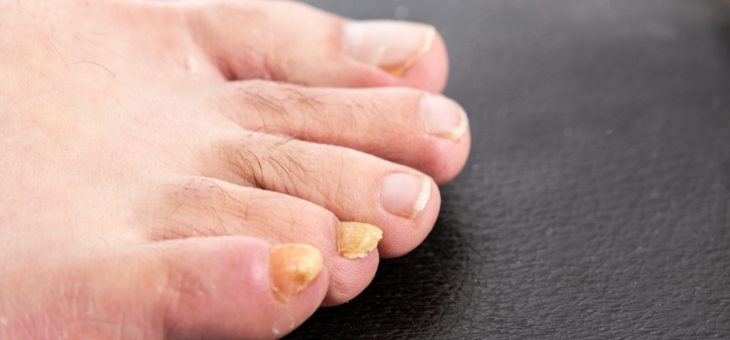Healthy toenails are smooth in texture and even in colouring. As you age, it’s normal for your toenails to change.
You may develop vertical ridges or nails may become more brittle. These changes are not a cause for worry.
Abnormalities from injury, spots, discolouration and nail separation should heal if treated accordingly.
However, there are several nail abnormalities that could signal health problems as certain medical conditions can change the appearance of your toenails.
Toenail health is important. You should see your doctor if you notice any of these symptoms:
-
- discolouration (dark or white streaks, changes in colour)
-
- changes in nail shape (curling or clubbing)
-
- changes in nail thickness (thickening or thinning)
-
- changes in texture (brittle or pitted nails)
-
- bleeding, swelling or redness around nails
-
- a nail that is separating from the skin
-
- general persistent pain
These changes can be symptomatic of various medical conditions.
Read: Your feet are your friends – here’s how to treat them properly
Black toenail
Black toenails are generally a result of a bruise under the nail and usually harmless. You can get a black nail from stubbing a toe or from footwear that crams your feet. Bruises of this kind usually start off a reddish colour, then turn purple, dark brown and eventually black when the blood underneath the nail dries and clots. It can take six months or longer for toenails to grow out.
Black toenail (rare causes)
In cases where that black toenail isn’t caused by a bruise, there is the chance it could be a more serious condition. Melanonychia is the term for brown (and sometimes black) colour on your toenails. Brown usually presents as a line or streak running up and down the nail. It may indicate:
-
- chronic ingrown nail
-
- malignant melanoma (skin cancer)
-
- inflammatory conditions
-
- fungal infection
-
- reaction to certain medications
Read: Your posture can improve your mood
Yellow toenails
When nails turn yellow, it’s usually a fungal infection. This can sometimes be treated with over-the-counter anti-fungal cream, so pop in to see your pharmacist. If the nail is very thick and yellow, try filing down the surface so the cream can penetrate deeper.
Green toenails
Unless it’s nail varnish, green is never a colour you want to see on your toenails. It may be a sign of a bacterial infection called green-nail syndrome (chloronychia), which thrives in damp or wet conditions. Tight-fitting shoes that you’ve worn over a long time, sponges and baths can be to blame. Your doctor can recommend treatment.
White toenails
If you toenails have turned white, crumbly and powdery, you could have a fungal infection. Visit your doctor for treatment.
Read: Are your feet killing you?
Candy cane stripes
Not the fun kind of candy canes. When your toenails have red and white stripes, this usually indicates a problem elsewhere in your body. If you notice lines and V-shaped nicks, you might have Darier’s disease, which is an inherited disease. It mostly affects the skin and causes greasy, warty, smelly blemishes.
Changes in your toenails are usually harmless and nothing to be concerned about. But because there’s a chance your abnormal toenail could be a sign of something serious, it’s best to play it safe and have a doctor check it out.
Do you seek help when you notice odd changes to your toenails or hope they will just go away? Why not share your thoughts in the comments section below?

